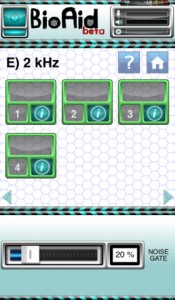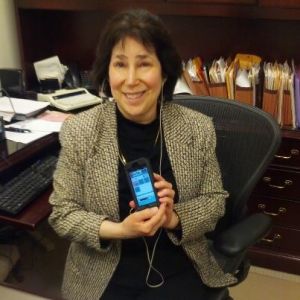Researchers at Essex University (in Colchester, England) have developed a free mobile app that turns an iPhone or iPod into a hearing aid.
The BioAid app is said to replicate the complexities of the human ear, unlike standard hearing aids that amplify all sounds.
BioAid, which is available on iTunes, has been developed by Professor Ray Meddis of Essex’s Department of Psychology with Nick Clark, formerly a Research Officer  in the Department and Dr. Wendy Lecluyse of University Campus Suffolk.
in the Department and Dr. Wendy Lecluyse of University Campus Suffolk.
According to its developers, BioAid is a multi-channel device where sounds are input through the mobile device’s microphone and then filtered into frequency bands. Each band is processed separately and the output from each channel is combined to make the output that is delivered to the device’s earpieces.
Unlike standard aids that have a single setting, BioAid has six fixed settings each of which has four fine-tuning settings allowing the user to find the perfect match for their impairment.
In a statement, Prof Meddis said, ‘People with hearing impairment very often withdraw from public life. Even if they have a hearing aid, the technology is not sophisticated enough to offer a tailor-made solution to their impairment and in many cases people simply stop using them.
‘Sounds are a complicated mixture of different frequencies and hearing loss is usually a loss of sensitivity to some but not all frequencies. Standard hearing aids amplify some frequencies more than others but BioAid is different because it also compresses the very loud sounds that can make social situations like going to the pub, cinema or a birthday party intolerable.’
Clark added, ‘The mobile phone is a great platform for rapidly transferring hearing aid technology from the laboratory to the hands of the public. Standard hearing aids…are only dispensed by a professional after a hearing test. BioAid offers a simple alternative…The hearing test is replaced by an exploratory process, allowing users to find which setting works best for them. In the short term, people unsure about visiting a hearing care professional might be swayed to do so by BioAid, which can only be a good thing.’
the public. Standard hearing aids…are only dispensed by a professional after a hearing test. BioAid offers a simple alternative…The hearing test is replaced by an exploratory process, allowing users to find which setting works best for them. In the short term, people unsure about visiting a hearing care professional might be swayed to do so by BioAid, which can only be a good thing.’
As phones get smaller and technology continues to advance, the researchers believe the BioAid project has the potential to radically change the future of hearing devices.
Professor Meddis said, ‘With the BioAid algorithm and wi-fi technology, we could see dispensers able to remotely adjust the settings on a phone-based aid and even monitor use to ensure the user is getting the most out of it.’
The development of BioAid, which has been funded by the EPSRC and hearing technology manufacturer Phonak, is part of a research project to influence the future of hearing aids.
The researchers say they are keen to hear about people’s experiences using BioAid so that they can continue to perfect the technology.
Testing of App
Before writing this blog article, I decided to download the BioAid and test it myself.
Figuring out the app wasn’t as intuitive as I had expected. Once I got the used to the controls I was able to clearly make out what was being said. I liked the fact that when I turned the app on, the sound “ramped up” instead of just blearing the sound. What I didn’t like was that I could hear so much background noise – the rain outside, the pitter-patter of the dog’s feet and the humming of the appliances in my kitchen. Of course background noise is one of the biggest complaints that we hear about hearing aids in general. And when using ear buds and turning up the amplifier, I started to experience a bit of feedback.
I think the BioAid is a neat cell phone app and I understand that it’s not a real hearing instrument. If I asked any of our patients to use the app, I think they’ll get frustrated with the controls and stop using it in less than two minutes. I also cannot imagine that any of our patients will be willing to wear ear buds or headphones that are connected to a cell phone.
There are, however, situations where I think BioAid can work. For instance if a patient is sick, in the hospital and their hearing aids are not working … a sound amplifier such as BioAid can be of great assistance. But I certainly do not ever foresee going to a restaurant and seeing a table full of older adults wearing headphones and their iPhones or iPads sitting on the table using the BioAid (or any sound amplifier for that matter).



This looks great for people with hearing loss. And a good reason to get an iPhone!
This is so cool. Never knew you could control your hearing aids with an iPhone.
Very interesting. I will have to go to the app store and look for some of these apps. Thank you.